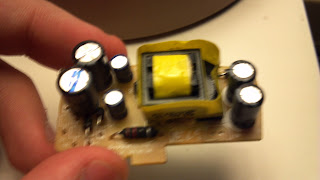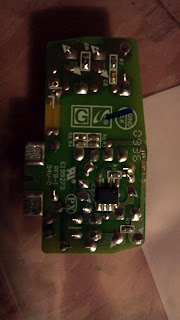- resistors
- transistors
- diodes (Light Emitting Diodes, e.g.)
- capacitors
- inductors
- wires
- power source
- Integrated Circuits (made up of all the other blocks)
By combining them, that's how! For example, your phone charger takes the hefty 120 volts from American standard outlets, uses an incuctor to bump it down to a nice 5 volts, then uses a set of 4 diodes (called a bridge rectifier) to turn AC into DC. Okay. So that's a fair amount of jargon. Let me break it down even more.
The wall outlet in your dorm is 120 volts. That's kind of a lot. Why? Because whatever you plug into it is probably going to need less than that. That's why you can't plug your computer into the wall; the 120 volts current would fry your computer. In fact, it only takes one tenth of that to fry the ram in your computer. So the "wall warts" take the 120 volts, which is in AC, and turns it into 5 volts DC. It does this by limiting the amount of electrons flowing with resistors, taking the AC voltage (which looks like a sine wave) and changing it to DC with diodes (which only let electricity flow in one direction) and smooth out the current with capacitors, which work like small batteries. A more in depth conversation can be seen here.
Well... This all seems pretty complicated, right? So how did I find out about it? Easy. I took things apart.
This is what I did today. I found an old phone charger, and took it apart. I pretty much found what I expected inside: A transformer, a few capacitors, a bridge rectifier, and a few resistors. Here's what I found:
Pretty cool, huh? Well, it gets cooler. There are plenty of tutorials on YouTube, and parts are cheap. I mean less than one dollar per component cheap. In fact, it's often cheaper to buy the parts in bulk, and build your own electronics. If you google parts, you will usually be able to find a way to purchase online. Handy! You can also get circuit boards you design created and mailed to you. Or, if you're Collin, you can etch your own! This practice, DIY, is very popular, and if you are interested, I would check out Make Magazine's website (and their YouTube channel is informative and entertaining too.) There's a whole world of electronics out there for you to discover if you want, and it's not incredibly difficult to break into. I turned my desk into a workstation, and I'm enjoying playing around with some basic circuits. And I'm not alone, there are tons of creations all over the net. Time to start creating!
http://makezine.com/ - All kinds of cool DIY projects.
http://www.youtube.com/user/Afrotechmods - Awesome videos on electronics basics


This is IMPRESSIVE. I tried to take apart my gps charger once because it was broken and I figured I'd be able to switch out the parts from another gps charger, but I was unsuccessful. More power to ya!
ReplyDelete